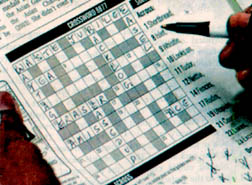
Puzzle it over
Millions of newspaper readers wake up to the excitement of being able
to work out the crossword puzzle.
Almost 30,000,000 Americans do the daily crossword in newspapers. The
New York Times employs a full time editor and numerous compilers who
spend the better part of the day creating new puzzles for the crossword
hungry readers.

Crossword puzzles are a development of the old word square, which
consisted of a set of words of the identical number of letters, which
had to be found and so arranged in a square, that they read the same
horizontally and vertically.
A few days before Christmas in 1913, Arthur Wynne, an editor at the
New York World was searching for an idea to spice up the Christmas
edition of the paper's Sunday supplement. In a couple of hours, he
created a puzzle and called it 'Wordcross'. The readers loved Wynne's 'Wordcross'
and demanded more.
Eleven years later, the first book of crossword puzzles appeared.
Overnight, a craze for the new brainteaser swept the U.S. and spread
through the world. Newspapers everywhere adopted the crossword as a
standard feature.
Britain succumbed to its craze in 1925, and soon developed her own
style, pattern and definitions. Crosswords now exsist in every language
except Chinese, which does not lend itself to this kind of up and down
manipulation of words.
In 1930, 'crossword' was included in dictionaries, a recognition well
deserved because these puzzles had boosted the sales of dictionaries.
This madness reached such a frenzy that at one point, librarians in
England had to blacken out the crossword puzzles in their newspapers, so
puzzle lovers wouldn't occupy the seats in the library or monopolise the
papers all day long.
The Hindu
Dancing is good for you

Dancing helps hyperactive (over-active) children to calm down, pay
attention in class and avoid getting into fights, a study has suggested.
Swedish researchers from Karlstad University and the University College
of Dance in Stockholm encouraged energetic movement in unruly (difficult
to control) boys aged five to seven with attention deficit hyperactivity
disorder (ADHD) - and found that their behaviour improved. Professor
Erna Gronlund, who led the study, said: "Boys with ADHD calmed down.
Their parents and teachers reported that they did their schoolwork
better.
One boy could only sit in a classroom for 10 minutes previously, and
after dance therapy, he could attend a whole lesson. These boys could
also play with other children without fighting all the time." Dancing
also helped depressed teenage girls, the researchers found.
The Daily Telegraph |


